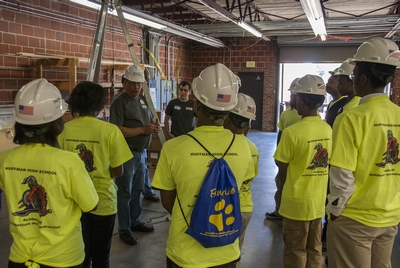
Increasingly, the construction industry is embracing the tenets of diversity and inclusion. This shift is propelled by a business case that highlights projected shortcomings related to talent and skilled labor. A recent industry report lays out the factors driving this trend.
Industry trending
According to the Bureau of Labor Statistics, the U.S. unemployment rate has dropped to a seven-year low of 5.1 percent. Simultaneously, U.S. labor-force participation has dipped to a 30-year low of 62.4 percent, and a global workforce shortage of 95 million people is projected by 20201. When combined, this all translates to a massive shortage of talent, an issue that is a hot topic within the construction industry in particular.
With the industry projected to grow 21.4 percent between 2012 and 20222 while grappling with an aging workforce and a shrinking pool of skilled labor, there is an increasing need to more vigorously attract, recruit and train new members of the workforce. Statistics indicate that these new workers will come from diverse populations and backgrounds.
Further widening the gap, the impact of the past economic recession has significantly reduced the availability of diverse subcontractors and vendors. All of these factors give rise to the recognition that it is in the industry’s best interest to promote diversity and inclusion in order to sustain success.
Diversity, inclusion are key drivers
As the industry begins to recognize diversity and inclusion as keys to our future sustainability, more leaders of top contractors are talking about initiatives to create a more diverse workforce.
For instance, the Associated Builders and Contractors held its first annual Diversity & Inclusion Summit in 2015 to discuss important issues related to diversity and inclusion within the industry. Also, the definition of diversity is expanding beyond the confines of race, gender, ethnicity and other traditional measures to include diversity of thought, background and experiences — particularly as a diverse set of perspectives has become widely accepted as a driver of innovation. Companies that understand the need for diversity and inclusion and develop policies and culture to support it are better poised to compete.
Competition, progression
In addition to a wider talent pool to draw from, these companies can benefit from improved employee retention and work relationships based on respect for differences, environments that foster innovation and a more diverse supply chain.
Further highlighting the necessity for the progression of diversity in the construction industry is the fact that customers buying construction services are leading the way in diversity and inclusion. These buyers are actively seeking construction firms complementary of their own cultures of inclusion.
Tools for success
As more members of the construction industry recognize the business case for a strong commitment to diversity and inclusion, and for companies beginning to embrace this tenet, several factors are keys to successfully demonstrate that commitment:
- Top-down commitment must begin with the CEO. Without the guidance, direction and support at the highest levels, diversity and inclusion efforts will not achieve success. While companies differ in the way they are structured organizationally to support diversity, there can be little measurable program and impact without the influence of the CEO. For example, at Brasfield & Gorrie, a commitment from the highest levels enabled the company to provide technical, management and financial support to diverse firms over the years. Staff also participated in company-initiated and federal mentor-protégé programs that help diverse businesses gain a foothold in the competitive construction industry.
- Diverse business participation. Firms need to take specific steps to maximize diverse business participation in projects. Examples of efforts to foster diverse business participation include :
- Business outreach events to inform prospective diverse business enterprises about upcoming opportunities.
- It is helpful when a company’s buyers or purchasers are also involved in outreach and networking opportunities. In this way, diverse businesses are able to communicate directly and develop relationships with the individuals ultimately responsible for making buying and contracting decisions.
- Fostering intentional inclusion. Employees can be critical allies in helping promote and strengthen diversity and inclusion efforts. For instance, companies demonstrating a commitment to advancing the role of women within the construction industry may utilize an employee resource group to enhance the recruitment, retention and development of women serving in operational roles. This resource can also be expanded to include members of other traditionally underrepresented groups.
Companies that focus on these factors of strong CEO support, diverse business participation and intentional inclusion will be well positioned as they work toward creating a more diverse and inclusive culture. While the construction industry is starting to gain positive momentum in working toward greater diversity and inclusion, there is always room for improvement in this key area that is so critical to the industry’s future.
1Source: http://www.mckinsey.com/insights/employment_and_growth/the_world_at_work.
2Source: U.S. Bureau of Labor Statistics.
Brian Murray serves as operations manager at Brasfield & Gorrie and is a member of the company’s Diversity and Inclusion Steering Committee.


 Join our thriving community of 70,000+ superintendents and trade professionals on LinkedIn!
Join our thriving community of 70,000+ superintendents and trade professionals on LinkedIn! Search our job board for your next opportunity, or post an opening within your company.
Search our job board for your next opportunity, or post an opening within your company. Subscribe to our monthly
Construction Superintendent eNewsletter and stay current.
Subscribe to our monthly
Construction Superintendent eNewsletter and stay current.